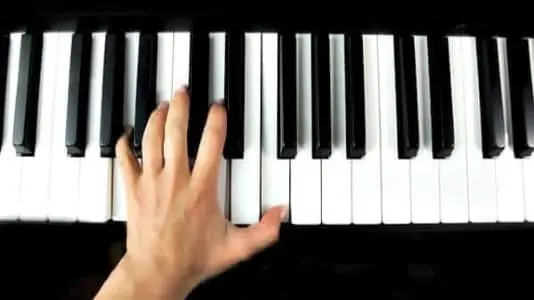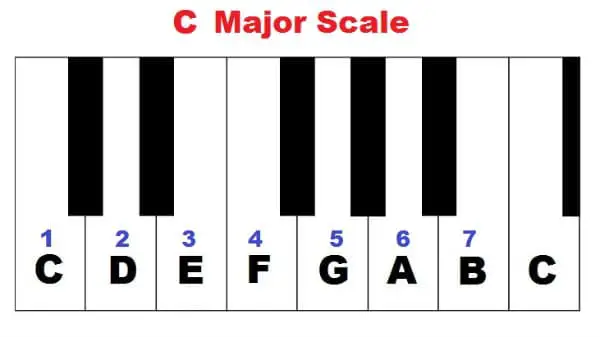- Home
- Piano Chords
- Chord Inversions
Learn and Play Piano Chord Inversions for Beginners
This article may contain compensated links. Please read the disclosure for more info.
What are Piano Chord Inversions?
When you play chord piano, you need to be able to move from chord to chord smoothly and with minimum effort. By inverting chords, you can do just that!
Chord Inversions
When you make a chord inversion, you simply rearrange the notes using the same notes in a different order.
- A triad (a three-note chord) in root position has the three notes spaced a third apart.
- A triad that is inverted has the notes spaced with an interval of a fourth and a third.
You are still using the same notes, but in a different order:

Why Use Inversions?

If you're an adult beginner learning how to play piano on your own, you might want to check out Piano For All. It's a resource that offers self-paced lessons so you can learn piano on your own schedule.
With its user-friendly approach, the resource provides a fun and engaging way to learn the basics of piano, such as reading sheet music, playing chords, and understanding rhythm.
When you know how to play chords in different positions or inversions, you can play chords following each other (chord progression) by choosing chord inversions that allows you to play with minimum movement from one chord to the next.
You want to avoid jumping with your hand like a kangaroo, but to slide effortlessly from one chord to the next. Try moving from one chord to the next by changing only one or two notes.
And- you want to be able to do it so that you can play it using only one hand. This is also called a close position. Get a keyboard chord chart here.
Chord Inversions & Construction
With a triad, or a three-note chord, you have three possibilities of inverted positions (piano chord inversions):
- Root position.
- First inversion (which has the third in the base), and
- Second inversion (which has the fifth in the base).
If you have a four-note chord, for example, a C7 (C, E, G, and Bb), you have four positions with also a third inversion that has the 7th in the bass.
 Inversions of a C major chord.
Inversions of a C major chord.TIP: An excellent exercise is practicing chords in all keys and inversions. Practice playing chords both blocked (all notes at once) and broken or as arpeggios (one music note at a time). Click here for a great resource.
Three Note Chords, or Triads
The C major triad has three notes. The root is C (red), the third is E (blue), and the fifth is G (green). This is called a C major chord in root position:

Using the same notes but moving the C (or the root) one octave higher, gives us the First Inversion:

And, moving the third one octave higher gives us the Second Inversion:

If we would move the fifth one octave higher we would return to the root position again one octave higher.
Four Note Chord Inversions, 7th Chords
7th chords are constructed with four notes, the root, third, fifth and seventh. It can be played in four inversions; the root position, 1st, 2nd and also 3rd Inversion (since it has four notes):
Root Position:

1st inversion (moves the root one octave higher):

2nd inversion (moves the third one octave higher):

3rd inversion (moves the fifth one octave higher):

All music chords can be inverted. As long as you don't change any of the notes because then it turns into another chord!
A chord with three notes will give you three inversions of the same chord. With a four-note chord, four inversions, and so on.
It is still the same chord, but you have now more choices for a smooth transition from one chord position to the next in what is called harmonic progression or chord progression.
Smooth progression using inversions
Play a smooth progression of two chords
When progressing from one chord to the next, first check what notes the chords have in common. For example, a C major chord contains the notes C-E-G, and an F major chord the notes F-A-C. The note C is a common note.
So, when moving from C major in root position (C-E-G) to F major (F-A-C) you can keep C (the note they have in common) and the other two notes have to move only one step up, from E to F and from G to A. This gives you an F major chord in the second inversion, C-F-A.
Step by Step Plan for Practicing Chords and Inversions
- Practice playing triads using only the white keys in the root position.
- Play chords from each note in the C major scale.
- Learn to see and hear if they are major, minor or diminished.
- Play only major chords on each step.
- Play only minor chords on each step.
- Practice each of the triads above as major, minor, diminished and augmented.
- Practice each of the major and minor chords above, with their two inversions.
- Learn the triads in root position starting from a black key. Play both major and minor.
- Learn all of the “black key” chords major, minor, diminished and augmented.
- Finally, learn to play the “black key” major and minor chords in all inversions.
By knowing about piano chords and chord inversions, it's easy to see how a piano composition is constructed and to be able to analyze some of the most common chords.
This, in turn, makes it easier to learn a new piece, since you now can "block out" and learn large parts of the composition, which often consists of chords in different shapes and inversions.





